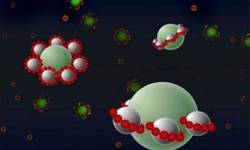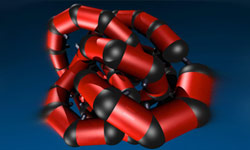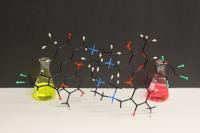Science
Galaxy Goes Green in Burning Stellar Fuel

The tiny red spot in this image is one of the most efficient star-making galaxies ever observed, converting gas into stars at the maximum possible rate. The galaxy is shown here in an image from NASA's Wide-field Infrared Survey Explorer (WISE), which first spotted the rare galaxy in infrared light.
- Read more
- 385 reads
Scientists provide 'new spin' on emerging quantum technologies

Images illustrate how collective spin excitations behave under the effect of the spin-orbit field, with and without external magnetic field.
- Read more
- 448 reads
New material approach should increase solar cell efficiency

The correlated electron metal SrRuO3 exhibits strong visible slight absorption. Overlaid here on the AM1.5G solar spectrum, it can be seen that SrRuO3 absorbs more than 75 times more light than TiO2. The structural, chemical, and electronic compatibility of TiO2 and SrRuO3 further enables the fabrication of heterojunctions with exciting photovoltaic and photocatalytic response driven by hot-carrier injection.
- Read more
- 325 reads
NASA's HyspIRI Sees the Forest for the Trees and More

The HyspIRI airborne campaign overflew California's San Andreas Fault on March 29, 2013. The three-color (red, green, blue) composite image of the fault (left), composed from AVIRIS data, is similar to what a snapshot from a consumer camera would show. The entirety of data from AVIRIS, however, spans the visible to the short-wavelength infrared part of the spectrum. Temperature information (right) was collected simultaneously by the MASTER instrument. Red areas are composed of minerals with high silica, such as urban areas, while darker and cooler areas are composed of water and heavy vegetation.
- Read more
- 328 reads
Three Years of SDO Images

This image is a composite of 25 separate images spanning the period of April 16, 2012, to April 15, 2013. It uses the SDO AIA wavelength of 171 angstroms and reveals the zones on the sun where active regions are most common during this part of the solar cycle.
- Read more
- 359 reads
Physicists find right (and left) solution for on-chip optics

Two different devices based on the herringbone pattern were presented in the Science paper: a rectangular array and a ring-shaped array (both interpreted in this illustration). Circularly polarized light with waves that wind in opposite directions gets split by both devices, with its waves routed in opposite directions. For a ring-shaped coupler, this means that plasmons are channeled either toward or away from the center of the structure. Intensity at the center of the ring can therefore be switched on and off by manipulating the polarization of the incoming light.
- Read more
- 337 reads
Zinc Oxide, Hydroxide Nanoparticles Utilized in Detecting Drugs

- Read more
- 357 reads
Multi-Walled Carbon Nanotubes Used in Producing DNA Biosensors

- Read more
- 384 reads
Ultrafast technique unlocks design principles of quantum biology

University of Chicago researchers have created a synthetic compound that mimics the complex quantum dynamics observed in photosynthesis. The compound may enable fundamentally new routes to creative solar light harvesting technologies.
- Read more
- 442 reads
Revolutionary new device joins world of smart electronics: Unique properties of graphene and graph Exeter combine to create a new flexible, transparent, photosensitive device
At just a few atoms thick, the newly developed photoelectric device is ultra-lightweight. This, along with the flexibility of its constituent graphene materials, makes it perfect for incorporating into clothing. Such devices could be used to develop photovoltaic textiles enabling clothes to act as solar panels and charge mobile phones while they are being worn.
- Read more
- 297 reads
Human Rights
Fostering a More Humane World: The 28th Eurasian Economic Summi

Conscience, Hope, and Action: Keys to Global Peace and Sustainability

Ringing FOWPAL’s Peace Bell for the World:Nobel Peace Prize Laureates’ Visions and Actions

Protecting the World’s Cultural Diversity for a Sustainable Future

Puppet Show I International Friendship Day 2020

